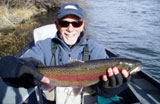Description
The Triple Double.
The Triple Double stole the show for me
recently on the Green River in Utah. The
first day found me wade fishing from the
trail along the upper section (called the
“A” section) just below Flaming Gorge dam.
Since this was my first trip to this
beautiful desert canyon stream, I didn’t
know what to expect beyond what I’d been
told by friends who’d been there in the
past. I’d been told that the water is clear
and that the fish count is huge. I quickly
learned that both of those comments were
understated. Standing on a high spot on the
trail, I saw so many fish—all large—working
both on and beneath the surface that I had
to pinch myself to be sure I hadn’t died and
gone to heaven. I’d tied hundreds of the
flies suggested by well-meaning friends, and
was anxious to begin fooling some of those
shadowy beasts. Well, the fish aren’t so
easily fooled—they’ve seen thousands of
flies flung at them from both shore and
boats, and they are wary. Suffice it to say
that I fished hard all day and ended up with
around ten fish—a mix of rainbows, browns,
and cutthroats all on tiny nymphs save one
caught on a small dry fly.
The next day I fished with guide James
Boehm. As we left the put-in, I asked for
his thoughts on how we’d be fishing that
day. His response: we’ll stick to dry flies
until it’s absolutely clear that we have to
go to nymphs. I was delighted—albeit a bit
skeptical, given my experience from the
previous day. I watched as he rigged my rod
with two dries—the topmost being a
white-posted black ant with a #16 Triple
Double at the point. The T-D was small and
goofy-looking but I figured James knew what
he was doing. We fished it all day and
spanked ‘em. We talked—and laughed—over
lunch about the odd little fella and kept
coming back to the same point—it just works,
Lord knows why. It looks a lot like the old
fore-‘n-aft Renegade pattern, but features a
third hackle in the middle. On the third day
I again fished from the trail, this time
from the bottom up three miles. The T-D
worked again, although not as well as it had
from the boat.
So I thought it would be fun to share the
T-D and feature it in this column. I suggest
that you tie this bug in small sizes for
those rare days during winter when dries
have a chance, and perhaps in larger sizes
(up to #14) for the spring on both streams
and lakes.
I’ll be tying this fly at the November
meeting, so if you have any questions you
can resolve them there.
Tying Instructions
|
|
We'll tie a #14:
1. Smash the hook barb unless you
are using a barbless hook. Cover the
hook shank with thread.
2. Just above the back of the barb tie on a
#16 grizzly hackle. Wrap the grizzly hackle
at that point. Two or three wraps will
suffice. |
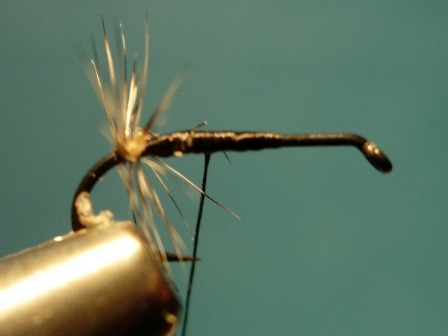 |
|
|
|
|
3. Dub the rear third of the shank in the shape of an ant abdomen, just in front
of the rear hackle. |
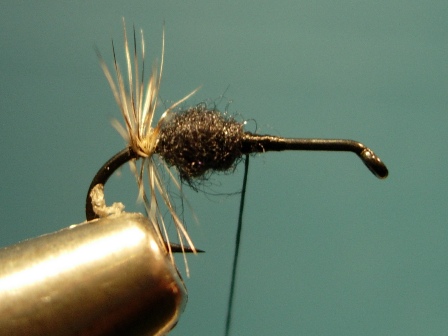 |
|
|
|
|
4. Tie on the middle hackle (size 14) just
ahead of the abdomen, and wrap it at that
point. Again two or three wraps will be
sufficient. |
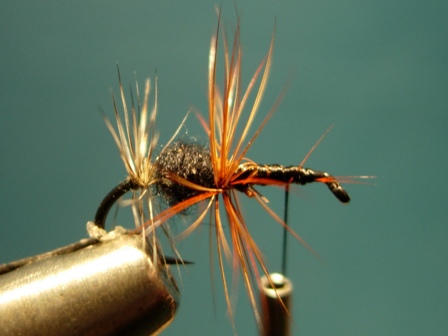 |
|
|
|
|
5. Just ahead of the middle hackle, dub the
thorax. It should be a tiny bit smaller than
the abdomen, as in the case of an ant
pattern. |
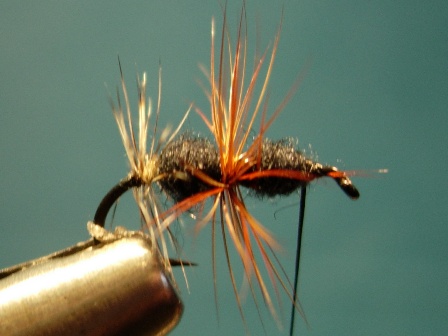 |
|
|
|
|
6. Tie in the front hackle (size 12)
in front of the thorax and wrap it
there, using two or three wraps.
7. Form a small thread head and whip finish.
|
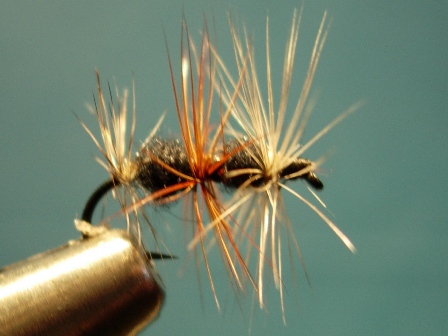 |
|
|
|
|
Tying
Tips
1. Use only high-quality dry fly
hackle. I prefer the long, uniform
saddle hackles because you can get a
lot of flies from a single one.
Don’t attempt this fly with inferior
hackle—it will be a frustrating
experience.
2. Keep it sparse. I think
the success of this fly is tied to its exceptionally sparse appearance, which
allows the inner body to show through.
3. Clip the bottom of the
hackle even with the hook point for better floatation.
Green River Guides jokingly call this critter a “no see-um” because its neutral
colors and appearance make it hard to see on the water even with polarized
lenses. That’s why my guide James placed an “indicator” dry fly above the T-D.
Leave about 24” between the flies and keep them separated on the water by
lifting your rod when necessary to pull them apart. I discovered that using a
large indicator dry fly such as a hopper did not produce as well. The reason?
The bigger fly tended to dominate and pull the T-D around and make it drag. A
small indicator fly won’t do that. |
|
|
|
|
 |
|

